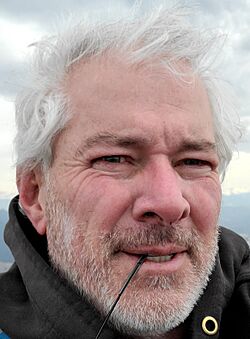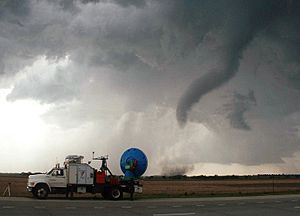Joshua Wurman facts for kids
Quick facts for kids
Josh Wurman
|
|
|---|---|

Joshua Wurman, creator of DOW
|
|
| Born | October 1, 1960 |
| Alma mater | Massachusetts Institute of Technology (S.B., 1982; S.M., 1982; Sc.D., 1991) |
| Known for | Weather radar, tornado, and hurricane research; field research and inventions |
| Scientific career | |
| Fields | Atmospheric sciences |
| Institutions | National Center for Atmospheric Research University of Illinois Urbana-Champaign University of Oklahoma Center for Severe Weather Research |
| Thesis | Forcing Mechanisms of Thunderstorm Downdrafts (1991) |
| Doctoral advisor | Earle Williams |
| Other academic advisors | Raymond Pierrehumbert Fred Sanders |
Joshua Michael Aaron Ryder Wurman is an American scientist and inventor. He was born on October 1, 1960. He is well-known for his work studying tornadoes, tropical cyclones (like hurricanes), and weather radar. He also invented special mobile radars called DOW and other radar systems.
Contents
Early Life and Education
Joshua Wurman went to Radnor High School in Pennsylvania. He studied at the MIT. There, he earned several degrees. He got a Bachelor of Science degree in physics and science in 1982. He also received a Master of Science degree in meteorology in 1982. Later, in 1991, he earned his Doctor of Science degree in meteorology.
Career in Weather Science
After college, Joshua Wurman moved to Boulder, Colorado. He worked at the National Center for Atmospheric Research (NCAR). Later, he moved to Norman, Oklahoma, and taught at the University of Oklahoma (OU).
In 1998, he started his own organization. It is called the Center for Severe Weather Research (CSWR). Wurman moved back to Boulder in 2001. Today, he and his special DOW radars are connected with the University of Alabama-Huntsville. His father, Richard Saul Wurman, is also famous. He is an architect and started the TED conferences.
Studying Storms and Weather
Wurman is very interested in how tornadoes form. He collects lots of information about how tornadoes are built and how they move. This helps scientists understand tornadoes better. He also discovered special wind patterns inside hurricanes. These include small, strong swirling winds called tornado-scale vortices (TSV). He wrote important papers about mapping tornado winds and finding multiple vortices inside tornadoes.
Joshua Wurman took part in big research projects. These were called the VORTEX projects. He used his first DOW radars in VORTEX1. He also helped lead VORTEX2, which happened from 2009 to 2010. During these projects, Wurman's team measured some of the fastest winds ever seen in a tornado. They also observed two of the largest tornado circulations.
Every spring, he leads a project called ROTATE. This project uses radars to observe tornadoes and thunderstorms. In the fall, he chases hurricanes to study them. He is also working on a project to study lake-effect snow.
Wurman has written many scientific papers. These papers are about hurricanes, tornadoes, and radar technology. His work has been published in important science journals. He wrote about what might happen if a big tornado hit a city. He also wrote a paper that showed tornadoes are often stronger than they appear from damage alone. Another paper linked hurricane tornado-scale vortices to very strong winds and damage.
New Radar Inventions
Wurman and his team created the DOW radars. These are mobile radars that can be driven close to storms. They are used to study tornadoes, tropical cyclones, wildfires, and winter storms. He built the first DOW in 1995 using parts from other places. By 2014, he had built eight DOW units. The success of the DOWs changed how scientists study severe storms. It led to many other mobile radars being used in weather research. The DOWs are now part of a larger system called the Flexible Array of Radars and Mesonets (FARM).
His team also developed other radar technologies. These include bistatic radar networks and the Rapid-Scan DOW. He holds several patents for his radar inventions. He even started a company called BINET Inc. in 1995.
Wurman also invented the C-band On Wheels (COW). This is a radar that can be set up quickly. He has suggested creating a network of S-band On Wheels (SOWs) to be part of the FARM system.
National Recognition
Joshua Wurman directs the DOW radar network. This network is a special facility for scientists. It is a key part of the Flexible Array of Radars and Mesonets (FARM). This facility is based in Boulder, Colorado.
His scientific work and DOW projects get support from many groups. These include the National Science Foundation (NSF) and the National Oceanic and Atmospheric Administration (NOAA). Other supporters are the United States Forest Service (USFS) and the United States Department of Energy (DOE). The Federal Aviation Administration (FAA) also helps. Even groups like The Discovery Channel and the National Geographic Society have supported his work.
Wurman is part of the USA Science and Engineering Festival's Nifty Fifty. This group includes important scientists and engineers in the United States. They work to get young people excited about science and engineering.
See also
- Doppler On Wheels
- Howard Bluestein
- Paul Markowski
- Erik N. Rasmussen
- Roger Wakimoto


